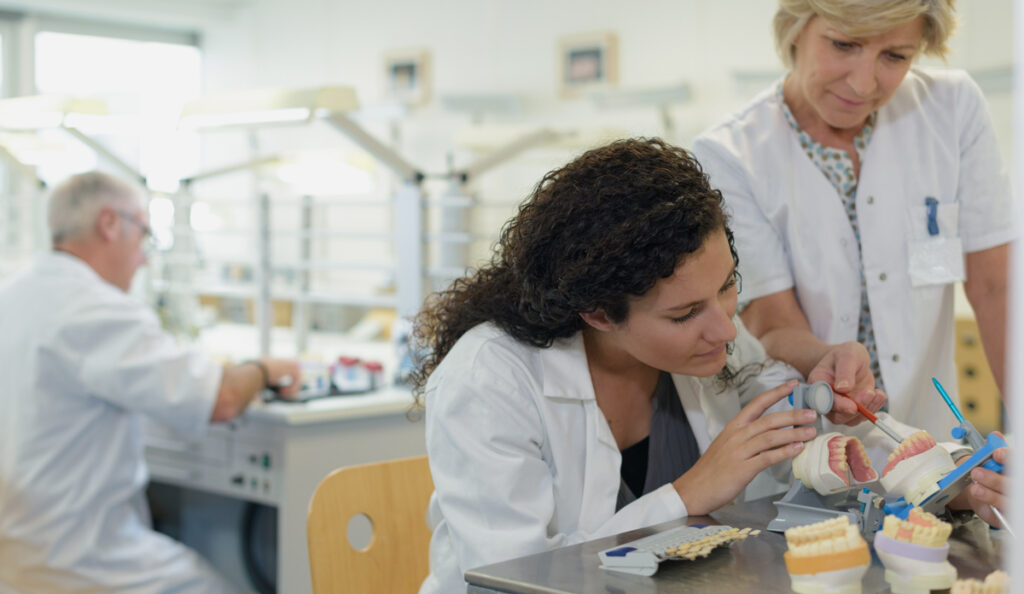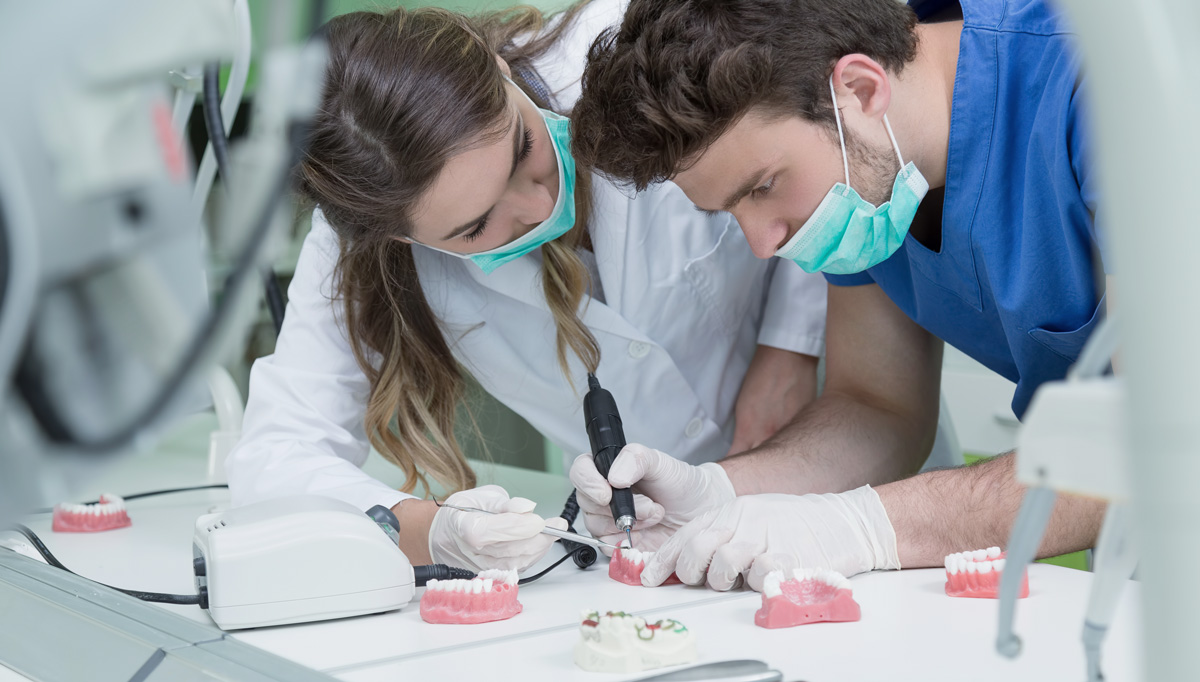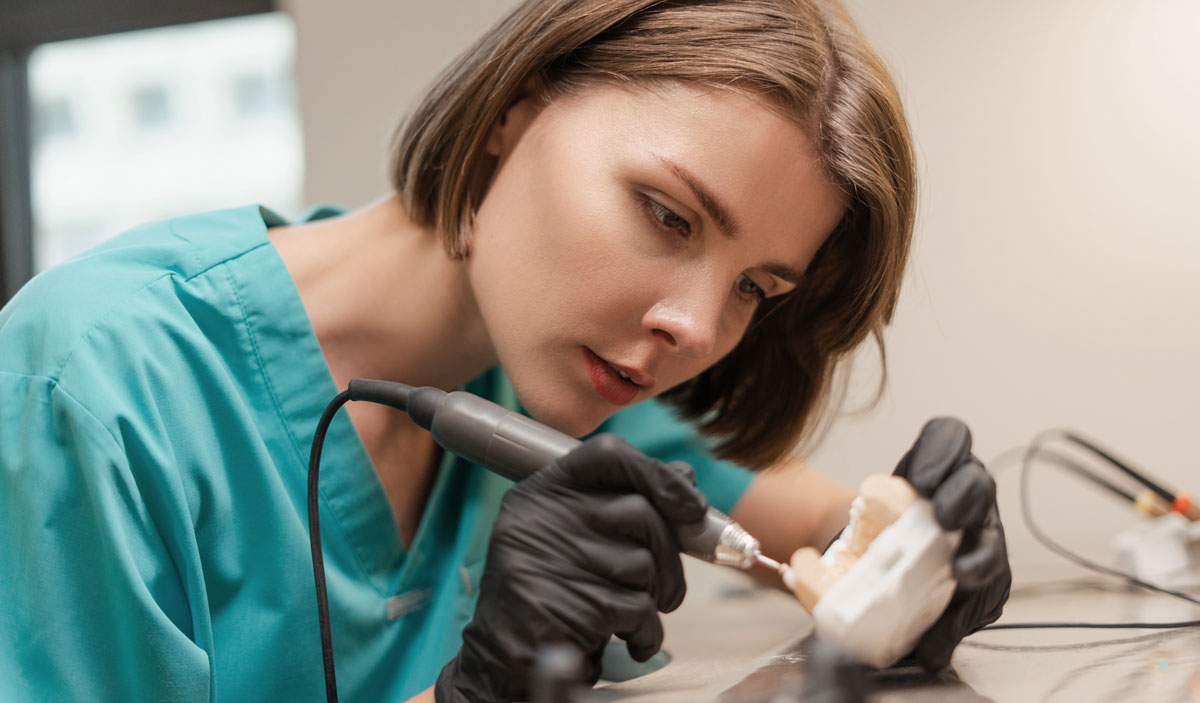Lab turnaround time in the UK is becoming an increasingly important factor for both patients and dentists who rely on efficient and accurate results. With demand rising, dental laboratories are under pressure to deliver a full range of services at high speed without compromising quality.
Dental technicians and GDC-registered dental technicians are working in a landscape where digital impressions, major scanners, and advanced technology are reshaping expectations. Patients now benefit from digital dentistry and digital cases that reduce wait times and improve outcomes.
By making use of the latest technology, dental labs can offer restorations and implants that provide natural aesthetics, while also meeting the high standards expected across the UK. Here’s how digital systems, expertise, and collaboration are helping dental technology improve lab turnaround time in the UK.
The current state of dental lab turnaround times in the UK
Pressures on laboratories
Laboratories across the UK must balance speed, cost, and quality. While NHS services face significant demand, private dental laboratories must also meet the needs of dentists who expect fast delivery of things like denture repairs, crowns, bridges, and implants.
Traditional methods often extend turnaround times, particularly when materials and impressions are sent by post. Delays affect how quickly a patient can receive treatment, and clients are increasingly looking to digital cases to reduce inefficiencies.
Impact of delays on patient care and healthcare systems
Every patient who requires restorations or dental implants feels the impact of delays. Longer lab turnaround time in the UK can affect treatment planning, slow down dentists, and create bottlenecks in services.
Crowns that take too long to produce may disrupt the entire treatment process, while bridges or implants that require adjustments can add further waiting. Improving speed without reducing quality is therefore essential if laboratories are to provide the highest level of service and maintain trust.
Common bottlenecks in laboratory workflows
Manual processes and paperwork
Despite advances in digital dentistry, some dental labs continue to rely on traditional impressions and manual forms. Paper-based processes extend turnaround times and increase the risk of errors.
A single missing detail or an unclear form can delay laboratory production, creating frustration for both dentists and patients.
Fragmented communication between departments
Dental laboratories often collaborate with multiple dentists and technicians, but poor communication can lead to inefficiency.
If digital impressions are not correctly transferred or if information about materials is incomplete, the laboratory team may need to pause production.
These breaks in workflow reduce speed and increase the likelihood that restorations will require review or adjustment before they can be supplied to clients.
The role of digital systems in streamlining operations
Laboratory Information Management Systems (LIMS)
Laboratories that adopt digital platforms such as LIMS can track every stage of the process more effectively.
From the moment digital impressions arrive to the point restorations are ready, the system provides a clear record. Dental technicians can review cases instantly, ensuring that dentists and patients benefit from a smoother service.
The ability to form digital workflows helps reduce delays, improve quality, and make sure that the latest technology is fully utilised.
Automated sample tracking and reporting
Automation is helping dental laboratories deliver services faster. Digital cases created with major scanners allow dental technicians to start production immediately, without waiting for physical impressions to arrive by post.
Automated reporting enables dentists to track progress, ensuring patients know when crowns, bridges, or implants will be prepared.
This digital form of communication ensures that services are delivered on time while maintaining high standards.

Enhancing collaboration and communication
Integrating digital platforms across care providers
One of the greatest benefits of digital dentistry is improved collaboration. By integrating digital platforms, dental laboratories and dentists can work closely, sharing knowledge and ensuring that restorations are specifically designed for each patient.
This full range of services allows dental laboratories to provide natural aesthetics while meeting the needs of clients across the UK.
Real-time updates for clinicians and patients
Digital systems provide real-time updates that assist both dentists and patients. A dental lab can send instant messages about progress, ensuring that everyone is prepared for the next stage of treatment.
This communication reduces uncertainty, helps laboratories deliver at the highest level, and allows patients to benefit from a smoother experience. It also assures dentists that if adjustments or editing are required, they can be managed without unnecessary delay.
Improving accuracy and compliance through automation
Reducing human error with digital tools
Manual techniques in dental technology are more prone to error, particularly when impressions are taken by hand. Digital impressions today, produced with major scanners, reduce the likelihood of mistakes and help laboratories achieve consistent accuracy.
Automation ensures that restorations are created with precise detail, improving fit, function, and aesthetics.
Meeting UK regulatory and quality standards
GDC-registered dental technicians must maintain high standards and comply with regulations across the UK. Digital systems make it easier to document processes, track materials, and demonstrate quality at every stage.
This approach helps make sure laboratories not only meet requirements but also provide a unique personalised service that goes the extra mile for patients.
Future opportunities for digital efficiency in UK labs
The potential of artificial intelligence and predictive analytics
The future of dental technology will be shaped by artificial intelligence and predictive analytics. These tools will assist dental laboratories in forecasting demand, reducing bottlenecks, and planning resources effectively.
AI may also play a role in reviewing digital impressions and suggesting techniques to improve restorations, further reducing lab turnaround time in the UK.
Building scalable, future-proof systems for dental laboratories
For dental laboratories, future-proofing services is essential. By investing in the latest technology, continuing education, and advanced digital techniques, laboratories can ensure they remain competitive.
A team of technicians with deep knowledge and expertise will be able to support dentists and patients by delivering a full range of dental products and restorations at high speed. The aim is not only to meet current expectations but also to assist clients in adapting to the future of digital dentistry.
Laboratories that embrace digital dentistry will benefit from shorter turnaround times, improved collaboration, and the ability to supply dental products at the highest level of quality. By working closely with laboratories that represent advanced technology, dentists know they will benefit from a unique personalised service and the expertise of GDC-registered dental technicians.
Start sending your cases to GoDigital Dental today!
At GoDigital Dental, we are more than just a dental laboratory. We are your committed partner in digital dentistry. By blending advanced technology with expert craftsmanship, our technicians deliver consistently accurate restorations, from crowns and bridges to implants and digital smile design.
We uphold the highest standards through our DAMAS and British Bite Mark accreditations, ensuring every case meets rigorous quality and compliance requirements. Our digital platform allows you to send cases directly through our portal, connect your scanner, and monitor progress in real time, helping you maintain speed without compromising on precision.
Start sending your cases to GoDigital Dental today and experience a lab that truly goes the extra mile. Together, we can elevate your patient care, reduce turnaround times, and achieve outstanding results through the power of digital dentistry.
How do digital technologies improve treatment planning for both the dentist and the patient?
Digital technologies make treatment planning faster, more accurate and easier for both dentists and patients. Tools such as intraoral scanners and digital imaging provide clear and detailed pictures of the mouth, helping dentists diagnose oral health conditions with greater accuracy.
Digital plans and smile design software allow patients to see possible treatment outcomes before treatment begins, which improves communication and confidence. For dentists, digital workflows reduce errors, speed up lab processes and cut down on remakes. For patients, this means fewer visits, shorter treatment times and a better overall experience.
Can digital treatment planning be applied to all types of dental procedures?
Yes, digital treatment planning can be used for a wide range of dental procedures. From dental implants and crowns to orthodontic appliances, teeth whitening and restorative treatment, digital tools help dentists plan and visualise the best approach. Intraoral scanners, cone beam computed tomography and CAD/CAM technology allow precise design and accurate results for both simple and complex cases.
Even aesthetic treatments like smile design benefit from digital planning. While traditional methods are still used in some situations, most modern dental practices can apply a digital approach to improve accuracy, reduce treatment time and enhance patient care.
What are the challenges or limitations of adopting digital treatment planning technologies?
Adopting digital treatment planning technologies can bring some challenges for dental practices. Initial costs for intraoral scanners, CAD/CAM systems and advanced software can be high. Staff need training to use digital tools effectively, which takes time and effort. Integrating new digital workflows with existing practice systems may also be difficult at first. Some complex cases might still require traditional impressions or methods.
Additionally, technology needs regular updates and maintenance to work reliably. Despite these challenges, many practices find that the benefits, such as faster treatment planning, accurate results and improved patient care, outweigh the limitations.
How long does it take to create a digital patient concept or virtual treatment plan?
The time needed to create a digital patient concept or virtual treatment plan depends on the complexity of the case. For simple treatments, such as teeth whitening or a single crown, it can take a few hours. More complex procedures, like dental implants, full smile design or multiple restorative treatments, may take a few days to complete.
Using digital tools, intraoral scanners, and advanced software speeds up the process compared with traditional methods. Digital treatment planning allows dentists to prepare accurate plans before the first visit, helping patients make informed decisions and reducing overall treatment time.
What are the data privacy concerns with cloud-based dental software?
Cloud-based dental software stores patient information online, which raises concerns about data security and privacy. Practices must ensure the software complies with UK data protection laws, including GDPR. Risks include unauthorised access, data breaches or accidental loss of digital records.
It is important to choose providers with strong encryption, secure servers and clear privacy policies. Staff should be trained to handle data responsibly and use secure login procedures. Despite these concerns, cloud-based systems can improve efficiency, digital workflows and patient care when proper security measures are in place, keeping patient information safe and confidential.
In what ways does digital treatment planning enhance patient communication and case acceptance?
Digital treatment planning helps dentists explain treatment options clearly to patients. Tools like digital smile design, 3D imaging and digital plans show patients what their teeth and smile could look like after treatment.
Seeing visual results helps patients understand the benefits of procedures such as dental implants, crowns or orthodontic appliances. It also allows patients to ask questions and make informed decisions. This improves trust between dentist and patient and often increases case acceptance.
By involving patients in the planning process, practices can enhance overall patient engagement, confidence and satisfaction with their dental care.
How do different digital components, such as CAD/CAM, intraoral scanners, and AI, work together?
In digital dentistry, different tools work together to improve treatment planning and outcomes. Intraoral scanners capture accurate digital impressions of a patient’s teeth and oral cavity. CAD/CAM software uses these scans to design restorations, crowns, bridges or orthodontic appliances with precision. AI can analyse the data, suggest optimal treatment options and help predict outcomes.
Together, these digital components create a complete digital plan, reduce errors, and speed up production in the lab. This integration allows dental professionals to deliver accurate results, minimise treatment time, and enhance the overall patient experience in modern dental practice.
What training is required for dentists to adopt digital planning?
Dentists need training to use digital planning tools effectively. This includes learning how to operate intraoral scanners, CAD/CAM systems, digital smile design software and treatment planning software. Training often covers capturing accurate digital impressions, designing restorations or orthodontic appliances, and using digital imaging for diagnosis.
Some courses also include guidance on integrating digital workflows into the dental practice and collaborating with digital labs. Hands-on practice and support from experienced technicians help dentists gain confidence. With proper training, practices can improve accuracy, reduce treatment time, enhance patient care and fully benefit from modern digital dentistry technologies.
How do dental labs ensure quality and precision with digital technology?
Dental labs use digital technology to produce accurate and high-quality restorations. Intraoral scanners and digital imaging capture detailed images of the oral cavity and the patient’s teeth. CAD/CAM systems and computer-aided manufacturing allow precise design and production of crowns, bridges, implants, and orthodontic appliances. Labs often use quality management systems, checking every restoration before it leaves the lab.
Advanced software and AI help reduce errors and improve consistency. Regular calibration of equipment and skilled technicians ensures reliable results. Digital workflows also allow labs to communicate closely with dental practices, supporting accurate treatment planning and predictable outcomes.
Can digital dental technology truly replace the artistry of traditional techniques?
Digital dental technology offers precision, speed and consistency, but it does not fully replace the artistry of traditional techniques. Skilled dental technicians and dentists still apply their expertise to achieve natural-looking results, especially for aesthetic treatments and customised restorations. Digital tools like CAD/CAM, intraoral scanners and digital smile design support and enhance this artistry by providing accurate data, reducing errors and improving planning.
By combining digital workflows with professional skill, dental practices can achieve both functional and aesthetic outcomes. The best results often come from integrating technology with the experience and creativity of dental professionals.



